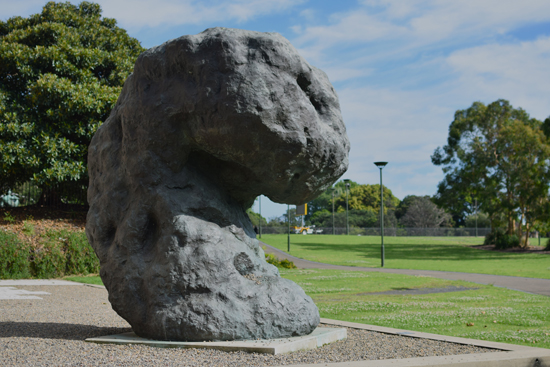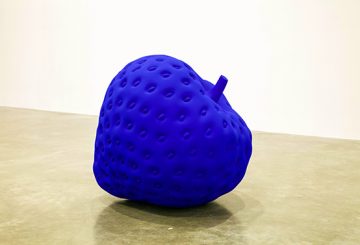From Ian Houston Shadwell…
Pop around the rear end of the Art Gallery of NSW and you will find a monolithic bronze sculpture oozing from its plinth, William Tucker’s Prometheus (for Kafka). A primeval, earthen lump of muddy metal close to three metres tall.
Its sculptor, William Tucker, is a card carrying Modernist, an art critic and teacher whose career was recently acknowledged by the International Sculpture Centre with a lifetime achievement award. He’s a serious man whose oeuvre shows a fascination with materiality and presence. But there’s no Modernist grids here. Instead it’s all formlessness and oozing. A sense of coming into being that is an invitation to metaphysical meditations on brutish realities. The imagery is base, bordering on the abject. This is an exploration of form which strikes a discomforting note and this unease is intrinsic to its effect.
This work is the antithesis of Brancusi’s Bird in Flight. The weight and texture of the Tucker appears as a formidable argument against Brancusi’s aspirations, throwing mud on the sleek, streamlined forms of the modernist dream. Yet all this fancy talk dances too delicately around the elephant in the room. It’s not mud he is throwing. The work is turd like. Irrefutably. A similar work by Tucker, Okeanos situated at the Helen L Dorris Campus in California, was so hated, or should we say, misunderstood that it was colloquially known as The Scripps Turd, in honour of the philanthropist who put it there.
More than a few of Tucker’s works tread this soggy line between “natural” form and scatology and it’s hard to imagine that this is accidental. After all, shit is a fascinating topic. Piero Manzoni famously canned his own, and one of the biggest draws at MONA is Wim Delvoye’s Cloaca Professional, 2010 an installation which makes shit. Presented in the right way shit can attract more than just flies. Yet, as fascinatingly abject as shit is, Tucker’s Prometheus has few fans. The work has languished behind the gallery, noted for being nothing more than turd like.
I was one of those who dismissed it. Yet it has always tugged at my curiosity. Who would make something so formidably unpleasant and why? Perhaps an aid in coming to grips with the work lies (as it so often does) in the title. Prometheus (for Kafka). Prometheus, of course, was the hipster who stole fire from the gods and was subsequently sentenced to the rather unpleasant punishment of having his liver ripped from his body for all eternity. He was, in a sense, the first post Lapsarian, plunging man into the hellishness of modernity on account of this theft.
Which brings us to Kafka. Kafka’s unpublished writings contained a discussion of four scenarios which described what may have “happened” to Prometheus once the gods had had their way with him. Of course, being Kafka, his first scenario begins with the idea that there’s not really a lot happening at all when your liver is being ripped from your undying body for all of eternity. It simply becomes a numb ritual empty of meaning or pain through the simple fact of its endless repetition. Everything gets dull eventually.
In the next scenario he imagines that the gods and the eagles forgot about Prometheus and even Prometheus himself forgot, so the whole thing just faded into a fog of absent mindedness. The alzheimer alternative.
The third scenario imagines that everyone grew weary of ripping the poor guys liver out and just gave the game up as being a little dull. Ennui rules, but who really cares? Huh?
Finally and I think this is the idea that fascinated Tucker, Prometheus was in such torment that he pressed himself into the rock, until he finally became the rock. This is what we’re staring at in Tucker’s work, the agonised figure of the man who gave us fire pushed within this lump of bronze. A scream of pure pain frozen for all eternity. As if this were really him and that somewhere behind us eagles fly ready once more to rip his liver from his body. It is a lasting testament to the idea that for Prometheus, at the very least, life is shit….


